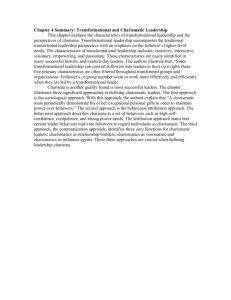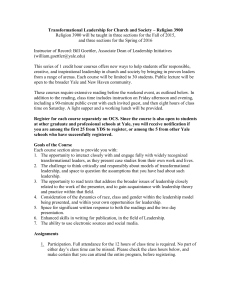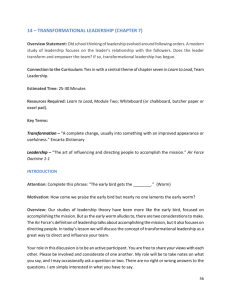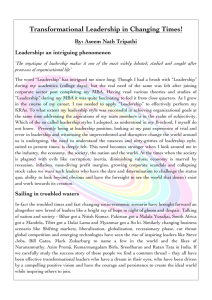Transformational leadership and its implications for the
advertisement
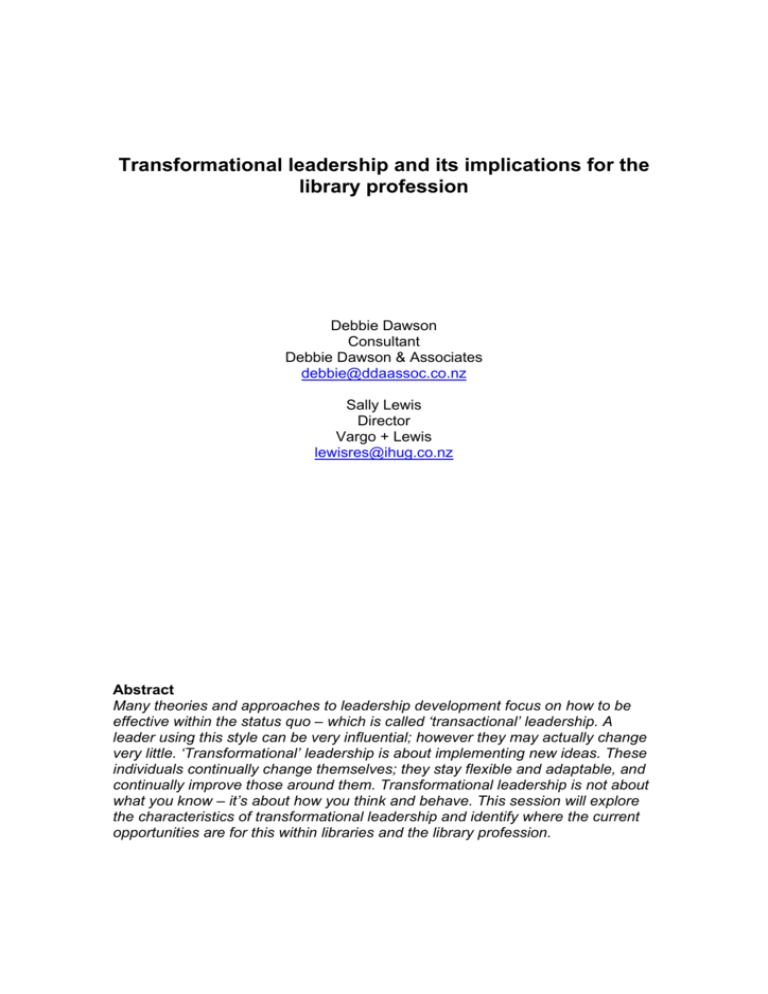
Transformational leadership and its implications for the library profession Debbie Dawson Consultant Debbie Dawson & Associates debbie@ddaassoc.co.nz Sally Lewis Director Vargo + Lewis lewisres@ihug.co.nz Abstract Many theories and approaches to leadership development focus on how to be effective within the status quo – which is called ‘transactional’ leadership. A leader using this style can be very influential; however they may actually change very little. ‘Transformational’ leadership is about implementing new ideas. These individuals continually change themselves; they stay flexible and adaptable, and continually improve those around them. Transformational leadership is not about what you know – it’s about how you think and behave. This session will explore the characteristics of transformational leadership and identify where the current opportunities are for this within libraries and the library profession. Introduction What we will cover in our presentation 1. Definition of ‘transformational’ and ‘incremental’ leadership 2. Provision of some examples to illustrate the difference 3. What does transformational leadership require of the leader and also of the follower? 4. Our observations as consultants to libraries as to the implications Definition of ‘transformational’ and ‘incremental’ leadership The essential difference between ‘incremental’ and ‘transformational’ leadership seems to hinge on the difference between managing the status quo through transactions focused on individual development and achievement of the performance contract on the one hand and taking people beyond their expectations into new territory through inspiration and stimulation. While some leadership research clearly separates transformational leadership from organisational transformations and places the emphasis on “transforming the hearts and minds of employees” we believe that where transformations occur in people, transformations in their work are not far behind. At times transformation in work operations becomes a catalyst for transformational leadership to occur. As Herb Kindler says in ‘Leadership Mastery in Turbulent Times’, “Transformational change alters a conceptual framework. Such change requires leadership because it threatens vested interests, challenges the competence of incumbents and, inevitably, bumps up against resistance. Despite these obstacles, its potential for renewal is compelling. “ Every radical thinker puts some portion of an apparently stable work in peril and no one can predict what will emerge in its place. - John Dewey Transformational leaders enable us to move even when we cannot be sure where we will end up. Most of the changes we put in place are incremental, namely refinements of a previous transformation. But sometimes incremental change just won’t do the job. As Kindler says, “Transformational leaders harness the winds that bring a change in kind, not just in degree; they move away from “that’s how we do things around here;” they seek revitalisation, not refinement.” He sets out the difference between leading incremental change and transformational change in this way:i Incremental Change Transformational Change Remain within the current system Replace the current system Follow precedent Disrupt precedent Refine and adjust Renew and start over Manoeuvre within maze walls Knock down maze walls Produce a change in degree Produce a change in kind Create ‘branch’ change Create ‘root’ change Aim at continuous improvement Re-engineer through innovation A key strength of a transformational leader is the ability to act on the opportunity to go beyond incremental change. Bill Gates’s quote on transformation – “you need to see your service is obsolete before the customer does. The only companies that succeed will be those who obsolete their own products before someone else does.” This means - don’t wait for a fall off in business or complaints to figure out a different approach is required. Provision of some examples to illustrate the difference What are some of the situations where you can’t be sure of where the destination will be? These may include • leaving a job; • changing a structure; • introducing a service; • stopping a service. Here are some of the changes we have seen in your libraries: • Joint service libraries to form a new identity • Introduction of computers into public areas • Increased electronic resources • Collaboration and consortia • Increased range of software applications and resources on public computers • Digitisation • Increased hours of opening • Development of learning centres and collaboration with the education sector • • • New service options e.g. library call centres, web based branches, combined service centres New building environments e.g. sustainability, co-location Introduction of pay-for word processing What are some of the changes you have seen in libraries – your libraries? Which of these changes are incremental and transformational? For example: 1. Introduction of computers into public places instead of backroom or information desk tools for librarians Transformational - Introduced a new sense of self-help which has changed the role of the librarian 2. Increase the number of applications on the public computers. Operational and incremental change 3. Seven day service and Increased hours of opening Transformational – highlights the library’s role in the community, connection with leisure and significantly increases access for specific groups of people. Increasing the hours open in a day may be an incremental change following on this transformational change. 4. Introduction of cafes Transformational - Instead of incremental changes such as introducing rules and regulations about hot drinks, water bottles, cell phones, etc – libraries provide a café for comfort and social interaction. This can completely transform the tone of the library and attract new users and type of use. There is a convergence of library functions with other pursuits. 5. Digitisation Transformational – move from preserving resources to making them accessible to increased numbers and at increased times. Moving from one to the other function and seeing that you can do both. Incremental – manual copying, and operating people-intensive services such as extended hours and security measures. How do we know when incremental or transformational change is required? Consider incremental change when:ii • The present system is adequate to support the desired vision and values. • A backlog of cost effective, incremental change options is available. • The competitive, regulatory, and technology environment in which you operate are relatively stable and predictable. Consider transformational change when: • The current system no longer yields acceptable progress toward the organisation’s objectives. • Turbulent conditions require a fundamental change. • You are prepared to address such staff resistance as concern about job security or concern about maintaining future competence in a new and unfamiliar system. What does transformational leadership require of the leader and also of the follower? None of the transformational changes we have looked at in libraries happened without transformational leaders pushing these things along from a germ of an idea. Many of the changes were new to libraries and had no precedents. It’s the ability of these leaders to see the germ in the first place, shape it, bring others on board, and think their way through the rivers of treacle and obstacles that emerge with change. The decisions made by these leaders to bounce back, reshape or abandon are all important. Transformational leadership is about more than just knowledge – it’s what you do with it. In order to transform our organisations we often need to transform ourselves. How do the transformational leaders need to be? It’s not about what you know – it’s about how you think. And the action you take. What are the leadership behaviours that enable any transformation – personally or organisationally? Vision Be able to see the possibilities and how libraries fit e.g. new technologies, convergence with other sectors such as education Ability to anticipate customer need and recognise obsolescence before they do Recognition that something new is needed instead of more refinement of what exists already Early adopters e.g. technology Courage Be willing to take the risk – not knowing exactly how things will turn out Be willing to test ideas and talk with others instead of endless personal research to come up with a perfect fully-formed solution See failures as things to be solved and rethought rather than a fatal block Be prepared to put yourself ‘out there’ Role-modelling Earn respect and trust by demonstrating the behaviours sought from others Reliable Demonstrate high moral and ethical standards Thinking ability intelligence & Ability to synthesise and sort new concepts and work with ambiguity Ability to think independently and about unpopular issues Ability to ‘think around corners’ Quickly understand the technical expertise and function of the organisation Sense-making Ability to link new concepts Ability to engage in the philosophical arguments and debate Decision-making Ability to make sound decisions without all the information Ability to make timely decisions to make the most of opportunities Optimism Recognise that there is no ‘one right way’ and believe that the change can actually be achieved Personal resilience to recover quickly from set backs Political savvy Know how to get things done Believe that others can contribute Recognise the importance of involving the ‘right’ people – be able to recognise the ‘right’ people! Use collaboration and partnership to get the best out of libraries Understand and take money accountabilities seriously Self-management Ability to achieve results through others and ‘let go’ Avoidance of obsessional and workaholic behaviours – know the times to work hard and when to play (can’t be a clock watcher!) Patience Be prepared to invest quality time with others so followers can understand and see the context for transformational change Perseverance Be able to deal with the resistance and fear Use ‘failures’ to inform the next effort, not as reasons to quit Some of this requires us to reinvent ourselves – how well can we reinvent the work without reinventing ourselves? What about the followers? Leaders must have followers. Ira Chaleff’s work on the ‘courageous follower’ directly addresses the challenge of joining in transformational leadership which can happen at all levels in the organisation. Being a follower is a powerful and responsible position. Followers are responsible. They … • Are not afraid of hard work • Take on tasks to lessen the load on the leader even in areas that require them to stretch • Stand up for the leader and the vision • Challenge the leader – loyalty can be blind and is therefore not always helpful for the leader • Are courageous enough to commit to and participate in the change – don’t sit on the sidelines waiting and seeing • Take care of themselves and question whether their values are congruent with the changes • Recognise that thinking is required by everyone in the organisation not just the leaders Followers are actually very powerful.iii Leaders are unable to effect change on their own. Followers manifest their power through: • The power of purpose, the strength that comes from commitment to the common good • The power of knowledge, the possession of skills and resources the organisation and its leadership value and do not want to lose • The power of personal history, a record of successes and unassailable contributions to the leader and the organisation • The power of faith in self, belief in our observations and intentions, in our integrity and commitment • The power to speak the truth, as we see it, to the leadership • The power to set a standard that influences others, to model values and behaviour for the leader and group members • The power to choose how to react in a situation regardless of what is done or threatened by others • The power to follow or not follow in a given direction • The power of relationships, of networks of people who know and trust • The power to communicate through a variety of channels • The power to organise others of like mind • The power to withdraw support if the leadership’s actions violate our values So which are you? A transformational leader, a courageous follower or neither? What does this mean for libraries? What’s the potential for transformational leadership in libraries? How will we need to revitalise ourselves and our work over the next decade? Which transformations are on the horizon? Some of you will have very specific answers to these questions. For ourselves, both as consultants working with libraries and as your customers, we see almost limitless potential in the decades ahead as libraries and library staff seek to create increasing relevance within the life of the community. Will you nurture the transformational leaders you need for this task?. In our work with libraries we notice some recurring situations which impact on the achievement of transformational change. These may or may not apply to you but ask yourself if they do and what you can do to advance. Some examples include: Putting things in boxes and seeing there is one right way to do everything There are a couple of variations on this theme. 1 – The Literature Search Transformational leaders and followers both need to resist putting things in boxes. Transformational leadership requires going beyond the box instead of always referring to what has gone before and looking for the solutions behind us. Sometimes it requires new thinking. In our experience a change management project in a library will almost always start with a literature search. This can be a good initial step to help start the thinking processes but there is more to the change than gathering the background information. At some point we need to ask ourselves “so what is this information telling us and what does it mean for us?” This is followed by analysis that can lead to strategies and a plan for action. Sometimes reports jump straight from the background information to the recommendations. Librarians are good at gathering the information and could get better at visibly evaluating and analysing the information – ‘so what does this mean for us now?’ Transformational leaders respect information but are independent thinkers. They are confident and optimistic enough to entertain new possibilities. 2 – The ‘Perfect Solution’ Another variation of the ‘one right way to do it’ thinking is the inability to see the development of an idea as iterative. Sometimes what we notice in libraries is a preference to gather the information, identify the ‘perfect’ solution, and then proceed to present the idea as a fully-formed package to the rest of the team. In terms of getting endorsement for an idea this is the most risky way to proceed. Colleagues hearing the idea for the first time may be caught off guard and withhold support simply because they have not had the chance to understand. By involving others along the way – by asking questions about their needs and testing our ideas we build support as we go, and by the time we present it to the team we have some supporters who already have a commitment to the end result. Why don’t we want to involve others as we form our ideas? The motivation for this may be varied – perhaps we lack confidence and want to avoid any negative feedback. Perhaps we believe that there is one perfect solution and if we read enough articles we will discover it and can save everyone time by coming up with it. Transformational leaders share their ideas and actively look for input to get the best and most workable solution. Can you move out of the research and perfect solution paradigm? Courage to think independently and be assertive Again there are a couple of variations on this theme 1 - The courage to raise Ideas This requires transformational leaders and followers to know themselves and to be assertive. Some employees tend to lack confidence and see themselves as ‘helpless’ particularly when wanting to raise and introduce new ideas. This can be about expecting too much from the official hierarchy instead of recognising that it’s not only those in formal leadership positions who can influence change. Instead of always looking upwards for solutions and actions we can look alongside us to those who have the best knowledge of the organisation and the operation. Instead of seeing ourselves as undermining our leadership by coming up with new ideas we need to see ourselves as helping them by generating ideas and being prepared to do the ‘so what’ thinking before we pass them on for approval. 2 – The courage to risk upsetting the status quo Transformational leaders have to be willing to upset people and be prepared to put themselves ‘out there’ in lonely places. In our experience there are leaders in libraries who struggle to maintain a healthy detachment from the personal issues associated with change in the workplace. Is this a gender issue for predominantly female organisations? There seems to be less confidence about stirring things up which can result in the postponement of timely transformation or a loss of opportunity that puts the whole organisation at risk. The requirement for transformations is unpredictable and ongoing With some of us there is the sense that once we have done this change we will have arrived at our destination and we can have a rest, consolidate and settle into maintenance. What often happens however is that one transformation leads to another. For instance, public libraries saw their connection with leisure pursuits in their communities, which then led to extended hours of opening, which then led to the provision of hospitality for the leisure and additional customers in the form of comfortable café spaces. Transformational leaders recognise that the change won’t end with the first transformation – that others will follow. And the key here is to know whether as a transformational leader you are prepared to start and follow through, and if you are not, then don’t even start. The question for these leaders is “Do you have the stamina to work with the unpredictability and the ongoing nature of transformational change?” Transformational leadership is not a oncer - it’s a process. These leaders understand the importance of timing, and that sometimes by waiting the world will have changed again. Transformation is not a destination, but a way of being. What does this mean for me? What would make me want to be involved in transformational leadership – either as the leader or the follower? Usually there are environmental factors that make people want to take this sort of action. For some they are driven by ideologies, their personal values, their support for a particular leader, or others in the team around them at the time. Sometimes there are people ‘for the time’. Do you know what the triggers are for you? “What would light my fire to do this or take it on?” So where do you want to be – in a transformational or incremental environment? You need to know what environment works for you. ‘Courageous followers’ take responsibility for their own happiness on the job and do this by pursuing the environment that best suits their needs. Sometime this will take a bit of searching or modification of expectations. For instance, do you want to be in an organisation that’s ‘going places’, a ‘leader in the field’ or do you want to be in one that follows on ten years behind taking a more conservative approach? Do you want to be in organisations that have limited support from funders both philosophically and financially or do you want to be in a well-supported one? What are you willing to do to build the environment you desire? Courageous followers decide to take action to change and give it their best shot (sometimes several shots!). Then if that doesn’t get the results they need, they have the courage to leave. Those who do not take responsibility for their fit with their environment can find themselves unhappily marooned in a ‘career wilderness’. Conclusion The first task for transformational leaders’ is to encourage and develop courageous followers, through their ability to communicate, provide vision, inspire, stimulate and walk their talk. When the leaders and the followers come together great things happen – unexpected things. The first step perhaps is willingness for both parties. This conference is a perfect time for you to explore both the ideas for transformational change and the opportunities for you to transform your own approach. You don’t have to wait for a transformational leader to ‘win your mind and heart’. You can engage your mind and heart and find others of like spirit to join you. Bibliography Chaleff, Ira., (1998). The courageous follower: standing up to and for our leaders. Berrett-Koehler Publishers. ISBN 1-880152-66-4 Jay, Ros., (2001). Winning minds. Capstone:Oxford. ISBN 1-84112-128-2 Kindler, Herb., (2006). Leadership mastery in turbulent times. Thomson:Boston. ISBN 1-59200-934-4 Reivich, Karen & Shatte, Andrew., (2002). The Resilience factor: 7 essential skills for overcoming life’s inevitable obstacles. Broadway Books:New York. ISBN 0-7679-1190-3 Endnotes i KINDLER, Herb – Leadership mastery in turbulent times, p113. Et.al. p118 iii CHALEFF, Ira - The courageous follower: standing up to and for our leaders. ii

